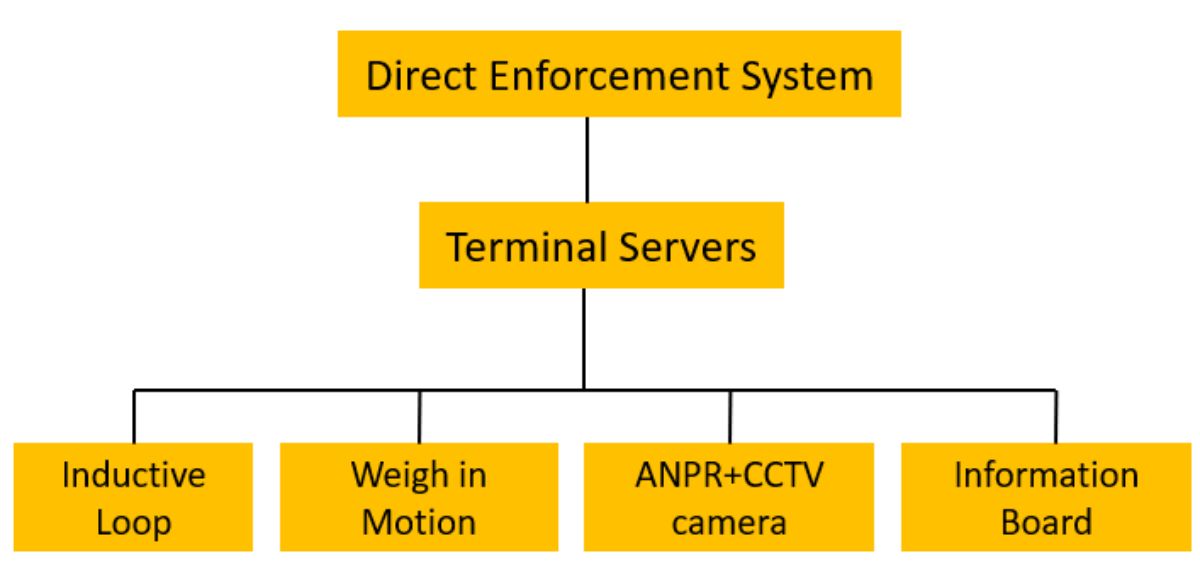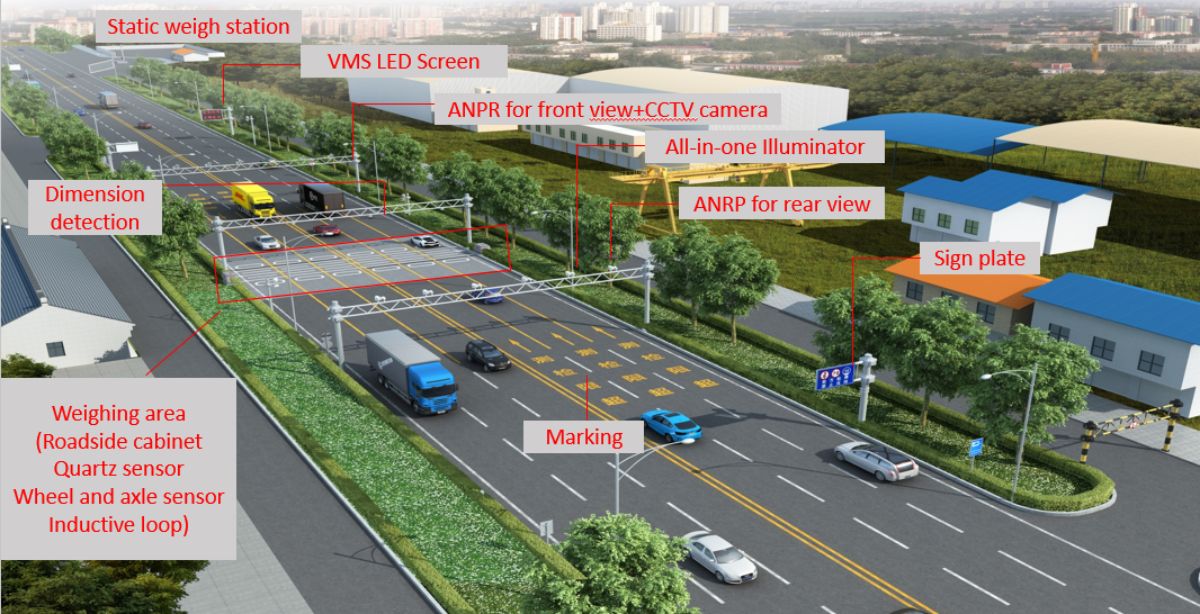Introduction
Illegal overloading and overloading of trucks not only destroys highways and bridge facilities, but also easily causes road traffic accidents and endangers the safety of people's lives and property. According to statistics, more than 80% of road traffic accidents caused by trucks are related to oversized and overloaded transportation.
The traditional overrun and overloaded transportation checkpoint mode has low law enforcement efficiency, which is easy to cause the phenomenon of overrun vehicle omission, and the direct enforcement detection point control mode relies on the dynamic automatic weighing and detection system to automatically detect, identify and screen the passing vehicles around the clock, so as to achieve accurate and efficient control of overrun and overloaded vehicles. In order to strengthen the governance of overloaded transportation behavior, ensure the safety of highway facilities and people's lives and property, the direct enforcement system of road overrun has gradually been fully promoted and applied in the highway, and the overrun control of highway has achieved remarkable results, and the control of highway overrun rate has been controlled within 0.5%, and the illegal overrun and overload of ordinary highways have also been effectively curbed.
The framework of the direct enforcement system
1. Framework and functions of the governance system
The direct enforcement mode refers to the automatic acquisition of relevant data such as the weight of passing vehicles through high-speed and accurate dynamic weighing equipment, so as to determine whether the freight vehicles are overloaded and transported, and rely on scientific and technological means to obtain evidence, and notify and deal with them afterwards.
The national network management information system is organized and constructed by the Ministry of Transport, and the provincial system data is connected and shared, providing support for the inter-ministerial and inter-provincial business coordination, and effectively supervising the national governance and super-governance work; The provincial-level project shall be organized and constructed by the provincial (autonomous region, municipal) transportation department to realize the functions of business management and service within the jurisdiction, support the provincial, municipal and county levels to carry out the work of inspection, and connect with the ministry-level system.
Taking Zhejiang as an example, the province's networked governance system adopts a four-layer structure and three-level management from top to bottom, which are as follows:
1) Provincial governance platform
It plays the role of six major platforms in the province's networked governance system, namely: basic data center platform, data exchange platform, administrative punishment platform, one-time illegal auxiliary judgment platform, assessment and evaluation platform and statistical analysis and display platform. Connect with the provincial government service network to obtain the matter database, discretionary database, and law enforcement personnel database, and report administrative punishment handling information in real time; Docking with the traffic police system to obtain freight vehicle information and driver information, copy illegal overrun transportation information; Docking with the transportation management system to obtain information on transportation enterprises, freight vehicles, etc., and copying illegal overrun transportation information; Unified document template and basic information and blacklist/license management of the governance station; Realize the auxiliary ruling of one penalty for one trip of oversized transportation; Assess and evaluate the operation of the province's monitoring stations and the operation of the super-control business; Through the statistics and analysis of data, the province's policy of governance and super-governance is evaluated, and quantitative support is provided for the introduction of the policy; Provide relevant legal and regulatory support for the work of governance at all levels, and establish a business database at the provincial, municipal, and county levels.
2) Prefecture-level governance super module
Responsible for the comprehensive management of basic business information within the jurisdiction, statistical analysis of overrun information, law enforcement inspection of the local city, administrative reconsideration of the case, business deployment, inspection and evaluation of the local city.
3) District and county governance super module
Receive and store the data of various overrun detection sites and facilities in the jurisdiction (including all kinds of overrun detection data, pictures and videos). Collect/review/confirm the illegal overrun data in the area, file archiving, and relevant statistics, analysis and display in the district and county.
4) Direct enforcement inspection stations
Through the dynamic weighing and capture forensics equipment set up on the road, the weight, license plate and other relevant information of the passing truck are obtained.
2. Composition and function of direct enforcement system
The field equipment of the direct enforcement system (see Figure 1) mainly includes automatic weighing and detection equipment, vehicle capture and identification equipment, illegal behavior notification facilities, video surveillance equipment, etc.
1) Weighing equipment: including weighing sensors, weighing controllers (industrial computers), car distributors, etc., should be verified by relevant qualified measurement institutions, and the weighing results can be used as the basis for punishment.
2) High-definition recognition and capture equipment: used to collect images of vehicles, including license plates, body conditions, license plate numbers and colors that can identify vehicles.
3) Video surveillance equipment: the use of video surveillance equipment to obtain the process of automatic weighing detection equipment for trucks, and the monitoring information obtained by video surveillance equipment can be used as evidence.
4) Information release equipment: through the variable information board, the vehicle that has been tested and overrun can be issued in real time to overrun the notice, and guide the truck driver to the nearest unloading site for unloading.

Design of direct enforcement detection points
Project site selection
In order to improve the effectiveness of overkill, direct enforcement inspection stations should be selected in accordance with the principle of "overall planning and unified layout", and priority should be given to roads with the following characteristics:
1) Trucks are seriously overrun or trucks must pass through the road;
2) roads connected to key protected bridges;
3) Provincial borders, municipal boundaries and other administrative areas junction roads;
4) Rural roads that are easy for vehicles to detour.
2. Weighing facility design
2.1. Dynamic Truck Scales
Dynamic truck scale is an automatic weighing instrument used to measure the longitudinal mass (gross weight), axle load, and axle group load when the vehicle passes, and it mainly has load
The device, the data processing part and the display instrument are composed, wherein the data processing part is usually designed in the form of a control cabinet. According to the different carriers, dynamic truck scales can be divided into vehicle type, axle load type, double platform type, axle group type, multi-arrangement combination type, and flat plate type can also be regarded as the category of axle group type. The working principle of the carrier is to measure the electrical signal when the carrier bears the tire load, and then convert it into the mass of the vehicle through amplification and signal processing, which can be divided into two categories: strain gauge type and quartz crystal type.
Under the condition of meeting the requirements of detection accuracy, the appropriate dynamic truck scale should be selected according to the road conditions, and the use of new technology weighing equipment with high precision, low cost and in line with standards should be encouraged, and the trucks that can be queued up and passed through the non-stop weighing detection area can be accurately separated.
2.2. Deployment of outfield equipment
Figure 2 is a typical layout diagram of direct enforcement stations, and Table 1 is the functional requirements of the main equipment. When the direct enforcement detection point is set on a single pavement road, a dynamic truck scale should be set on the entire road cross-section, and if the entire cross-section cannot be set up due to conditions, isolation facilities such as wrong-way driving and riding should be added to avoid vehicles evading weighing.

Figure 2. Typical diagram of the direct enforcement station
Table 1.Key Device Functional Requirements
| The name of the device | Key feature requirements: | |
| 1 | Dynamic truck scales | It can automatically detect the time, number of axles, speed, single axle axle load, total weight of vehicle and cargo, wheelbase and other information of the vehicle; It can accurately separate the queuing mode through the freight vehicle; It can deal with the abnormal driving state of freight vehicles such as lane change and speed breaking; It can transmit the front-end truck overrun information to the management system in real time; It can meet the uninterrupted all-weather continuous work in the unattended state; It should have a fault self-test function |
| 2 | License plate recognition and capture equipment | should be equipped with a fill light or flashing light; It can clearly capture the license plate number, has environmental protection configuration, and it is recommended to use a three-in-one fill light to avoid light pollution; Ability to capture images of freight vehicle number plates in full-frame JPG format; It should be able to capture 1 high-definition picture of the front, and according to the picture information, it should be able to clearly distinguish the license plate area of the freight vehicle, the front and cab features, and the color of the front of the car; The vehicle identification and capture equipment should be able to capture the image of the vehicle passing through the non-stop weighing detection area from multiple angles from the side and tail, and should be able to clearly distinguish the number of axles of the freight vehicle, the color of the body, and the basic situation of the transported goods according to the image information; Vehicle identification and capture equipment should have fault self-inspection function; The abnormal event capture device supports the detection function of abnormal vehicle crossing and compaction line. |
| 3 | Video surveillance equipment | Forensic images should be at least 2 million pixels and should be tamper-proof. |
| 4 | Information Publishing Equipment | It should be able to release the vehicle overrun detection information to the driver of the overrun vehicle in real time, and it should be able to realize text alternation, scrolling and other display methods. |
When a vehicle is detected to be suspected of being overloaded, the license plate will be displayed via a variable information board and the vehicle will be directed to a nearby overloaded transport checkpoint for processing. The setting distance between the information board and the dynamic truck scale should meet the requirements of vehicle vision, and it is recommended to choose the appropriate variable information board type and setting distance according to the road conditions; When the distance between the information board and the dynamic truck scale does not meet the driver's visibility requirements due to the road alignment conditions, it is recommended to limit the driving speed of the truck or adjust the angle of the information board LED particles to improve the driver's visibility time.
3. Design of measures to reduce weighing errors
According to the requirements of overload division in the penalty standard, in the case of running speed of 1~80km/h, the total weight of the vehicle and cargo in the dynamic weighing should meet the requirements of the accuracy level of 10, and the percentage of the agreed true value of the total weight of the vehicle does not exceed the error of the first inspection and subsequent inspection
± 5.00%, and the test error in use does not exceed ±10.0%.
In order to reduce the error caused by pavement factors to weighing, the pavement in the area that affects weighing before and after weighing equipment at direct enforcement stations should meet the following requirements:
1) The longitudinal slope should not be more than 2%, and the lateral slope of the pavement should not be more than 2%;
2) when on the cement pavement, a deformation joint, a tie rod and a filler are arranged between the backfill cement concrete and the existing cement pavement;
3) When on the asphalt pavement, a gradient transition is adopted between the backfill cement concrete and the existing asphalt surface course. Direction enforcement station
selection points should avoid being installed on the following road sections:
1) The road section within 200m from the level intersection;
2) the number of lanes changes in the road section;
3) overpass (aerodynamic influence) and approach bridge (poor uniformity) sections;
4) sections of bridges or other structures that will have a dynamic impact on vehicles;
5) Sections under or near radio transmission stations and railway tracks under high-voltage power lines.
In addition, in order to reduce the weighing error caused by the driving behavior of the vehicle, the following measures should be taken in the weighing section:
1) When the driving lane is multi-lane, the roadway dividing line adopts a solid line, and vehicles are prohibited from changing lanes;
2) When the road section alignment is good and easy to speed, set up the truck speed limit sign in front of the weighing detection area;
3) In order to crack down on driving behaviors that deliberately evade punishment such as blocking license plates, driving in the wrong direction, and queuing and tailgating, illegal capture and identification equipment can be added.
Conclusion
To sum up, the layout of direct enforcement detection points should be comprehensively determined after comprehensively considering the regional road network, road conditions and surrounding environment, and the design of reducing errors should be carried out according to the road conditions of the installation location to reduce the errors in the operation and maintenance process. In order to reduce the cost of weigh-in-motion construction, in addition to overall planning and reasonable selection of layout points, it is also necessary to clarify the management authority, coordinate the management from multiple departments and angles, and strive to reduce overload behavior from the source.

Enviko Technology Co.,Ltd
E-mail: info@enviko-tech.com
https://www.envikotech.com
Chengdu Office: No. 2004, Unit 1, Building 2, No. 158, Tianfu 4th Street, Hi-tech Zone, Chengdu
Hong Kong Office: 8F, Cheung Wang Building, 251 San Wui Street, Hong Kong
Factory: Building 36, Jinjialin Industrial Zone, Mianyang City, Sichuan Province
Post time: Mar-09-2024





